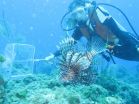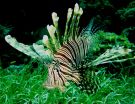(Press-News.org) CORVALLIS, Ore. - If you live in lionfish territory in the Atlantic Ocean, the last thing you want to be is a small fish with a long, skinny body, resting by yourself at night, near the bottom of the seafloor.
If so, your chances of being gobbled up by a lionfish increase by about 200 times.
Findings of a study on lionfish predation behavior, which may also apply to some other fish and animal species, have shed some new light on which types of fish are most likely to face attack by this invasive predator, which has disrupted ecosystems in much of the Caribbean Sea and parts of the Atlantic Ocean.
The research has been published in the Journal of Animal Ecology by scientists from Oregon State University and Simon Fraser University. It used the study of lionfish to gain broader insights into how predators select their prey, and developed a new method for predicting diet selection across various prey assemblages.
"With species now moving all over the world in both marine and terrestrial systems, we need to know who will eat whom when species encounter each other for the first time," said Stephanie Green, the David H. Smith Conservation Research Fellow in the OSU College of Science, who has done extensive studies of lionfish.
"Normally, predator-prey experiments take a lot of effort and time," Green said. "But there are mathematical techniques that can help us better understand what is happening when we observe animals hunting in the wild, and why some species get eaten and others don't."
Green said that researchers want to identify common features across the animal kingdom that make some species more vulnerable than others.
"We're playing catch-up on this," she said. "However, with the case of species invasions, a much better understanding of which native species are at risk can help us target management intervention. This could help avoid extirpations and, in the worst-case scenario, more outright extinctions."
This study is one of the first to identify general traits of prey that predict vulnerability to predation, and examine diet selection at different spatial scales. Some of the findings may be relevant to other invasive species problems, such as expansion of the Burmese python in the Florida Everglades and the spread of Asian tiger prawn into the Gulf of Mexico.
The study also showed that although lionfish have a voracious appetite and will eat almost any fish smaller than they are, they do have their favorites.
They find it easier to stalk and attack solitary fish, rather than those in schools. They like to hunt at dusk, near the bottom, and for some reason tend to avoid fish that clean off parasites from other fish species that are common in a marine environment.
"Fish that clean parasites off of other fish appear to be avoided by lionfish," Green said. "Those that don't will be much harder hit."
Having all the traits that make them vulnerable, for instance, raises a serious question about the ability of some species to survive the lionfish invasion, such as the Exuma Goby, a small fish native to one area of The Bahamas. It has many traits lionfish prefer.
OSU researchers are working with the International Union for Conservation of Nature to help identify some of the species and problem areas most at risk of extinction from the lionfish invasion, and where control of the invaders should be prioritized.
Lionfish are now established on coral reefs across the western Atlantic Ocean, Caribbean Sea and Gulf of Mexico, and the invasion continues to spread while reef biodiversity and biomass rapidly declines. The high rate of fish mortality also poses an additional threat to coral reefs themselves, which can become covered with algae if enough fish are not present to eat the algae and keep it under control.
INFORMATION:
The research was supported by the Natural Science and Engineering Research Council of Canada and the David H. Smith Conservation Research Program.
Editor's Note: Digital images and an audio podcast are available to illustrate this story.
Podcast, "Picky Eaters," about species diet preferences: http://bit.ly/1vpMcAA
Images, Stephanie Green capturing lionfish in The Bahamas: https://flic.kr/p/joY2X5
Hunting lionfish to reduce their populations: https://flic.kr/p/jgb8Lo
Lionfish near ocean bottom at dusk: https://flic.kr/p/q7NP65
Algae overgrowing on a coral reef: https://flic.kr/p/dbJWZr
Philadelphia, PA, November 24, 2014 - Pregnant women with diabetes are at an increased risk for many adverse birth outcomes. Preconception care (PCC) can significantly lower these risks by helping pregnant mothers with diabetes control their glucose levels, resulting in healthier babies and less money spent on complicated deliveries and lifelong medical complications. Effective, universal PCC for diabetic mothers could avert an estimated $5.5 billion in health expenditures and lost employment productivity over affected children's lifetimes, according to a new study published ...
This news release is available in German.
X-ray flashes are a unique scientific tool. They are generated by accelerating electrons to very high energy levels in kilometer-long vacuum tubes, so-called linear accelerators, and then deflecting them with specially arranged magnets. In the process the particles emit X-ray radiation that is amplified until an ultra-short and intensive X-ray flash is released.
Researchers use these X-ray flashes to resolve structures as small as one ten billionth of a meter (0.1 nanometer) in size. That is roughly the diameter of a ...
LA JOLLA, CA--November 24, 2014--A team led by scientists from The Scripps Research Institute (TSRI) has found a simple method to convert human skin cells into the specialized neurons that detect pain, itch, touch and other bodily sensations. These neurons are also affected by spinal cord injury and involved in Friedreich's ataxia, a devastating and currently incurable neurodegenerative disease that largely strikes children.
The discovery allows this broad class of human neurons and their sensory mechanisms to be studied relatively easily in the laboratory. The "induced ...
ANN ARBOR--Our bones are smart. Bones know that by adolescence it's time to stop growing longer and stronger, and from that point on bones keep their shape by healing injuries.
This question of why bones grow longer and stronger in children, but stay static in adults--yet retain the ability to heal themselves, has long perplexed scientists in the bone regeneration field. But researchers from the University of Michigan, Kyoto University and Harvard University believe they may have unearthed a big piece of this puzzle.
The team discovered that a certain subset of cartilage-making ...
VIDEO:
When zebrafish are infected with bright blue Mycobacterium marinum, bright red immune cells quickly surround the bacteria to form tightly organized nuggets called granulomas (vessels green, bacteria blue, immune cells...
Click here for more information.
DURHAM, N.C. -- The body responds to tuberculosis infection by locking the bacterial offenders into tiny clusters of immune cells called granulomas, which are a hallmark of the disease. This containment strategy succeeds ...
The structure of pores found in cell nuclei has been uncovered by a UCL-led team of scientists, revealing how they selectively block certain molecules from entering, protecting genetic material and normal cell functions. The discovery could lead to the development of new drugs against viruses that target the cell nucleus and new ways of delivering gene therapies, say the scientists behind the study.
At the heart of every cell in our body is a cell nucleus, a dense structure that contains our DNA. For a cell to function normally, it needs to surround its nucleus with a ...
The first detailed, high-resolution 3-D maps of Antarctic sea ice have been developed using an underwater robot. Scientists from the UK, USA and Australia say the new technology provides accurate ice thickness measurements from areas that were previously too difficult to access.
The results, published this week in the journal Nature Geoscience (Monday 24 November 2014), step up the pace of research in the polar regions aimed at understanding the dramatic sea ice changes in the context of climate change.
Scientists use a range of technologies and techniques to measure ...
Scientists have discovered a gene that protects people against one of the major causes of stroke in young and middle-aged adults and could hold the key to new treatments.
Researchers from Royal Holloway, University of London, together with an international team from across the United States and Europe, have found that people with a specific variant of a gene, known as PHACTR1, are at reduced risk of suffering cervical artery dissection, which is caused by a tear in an artery that leads to the brain.
The new discovery, published in the journal Nature Genetics, could ...
Scientists at the Helmholtz-Zentrum Dresden-Rossendorf (HZDR) have studied the dynamics of electrons from the "wonder material" graphene in a magnetic field for the first time. This led to the discovery of a seemingly paradoxical phenomenon in the material. Its understanding could make a new type of laser possible in the future. Together with researchers from Berlin, France, the Czech Republic and the United States, the scientists precisely described their observations in a model and have now published their findings in the scientific journal Nature Physics.
Graphene ...
Boston, MA - Researchers at Harvard School of Public Health (HSPH) have found a novel mechanism causing type 2 diabetes that could be targeted to prevent or treat the disease. The research highlights a previously unrecognized molecular pathway that contributes to the malfunction of liver cells in obesity, leading to insulin resistance and diabetes.
The study appears online November 24, 2014 in Nature Medicine.
"While it is well-established that obesity generates cellular and molecular stress leading to abnormal functioning of many cellular processes, the mechanisms ...







